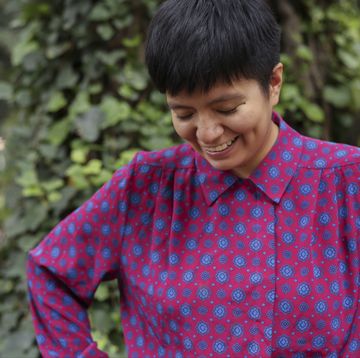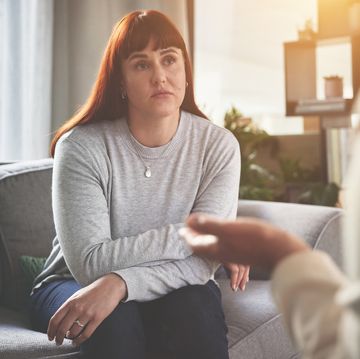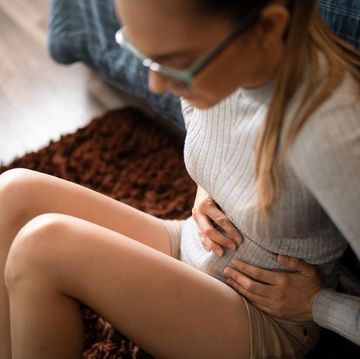I was 21 when a consultant suggested I be put on injections to induce a temporary, reversible menopause for my endometriosis pain. After a quick discussion of the side effects of the medication – which I was told could include hot flushes, insomnia and headaches – I declined.
I'd rather, I said, explore lifestyle changes and the potential of further surgeries to remove endometriosis tissue, which I had received in the past.
At the time, the response from the medical team made me feel like my symptoms can’t have been 'bad' enough if I turned down this treatment option. Subsequently, I was removed from the surgeon’s care and told there was nothing else that they could do for me.
To help to combat side effects, 'add-back' hormone replacement therapy (HRT) can be given alongside injections for chemical menopause.
Fast forward 7 years to the present, and the landscape feels different. As I've experienced it, more conversation is happening in both medical circles and among people with endometriosis around the possible issues with this medication, as well as its potential to help.
Endometriosis is a chronic condition in which cells, like the ones in the lining of the womb, are found elsewhere in the body. Each month, these endometriosis cells build up, then break down and bleed. This can cause debilitating pain.
So what precisely is a chemical menopause and what is the current discussion going on?
What is chemical menopause?
Chemical menopause is achieved via the injecting of a class of drugs known as gonadotropin-releasing hormone (GnRH) ago, explains Mr Amer Raza, lead endometriosis and robotic surgeon at the NHS Chelsea and Westminster hospital. These are goserelin acetate and leuprorelin, sold under the brand names Zoladex and Prostap, respectively.
While some people who suffer with endometriosis, like me, might be given this option, they are also sometimes used in the care of people with advanced breast cancer, to ease symptoms.
On GnRH analogues like Zoladex and Prostap for endometriosis, the NHS says: '[these are] are synthetic hormones that cause a temporary menopause by reducing the production of oestrogen. They're sometimes given if other hormone treatments are not right for you, to help reduce pain, or after laparoscopic surgery for a short time.'
As to how the medication works, in your body? '[Zoladex] suppresses your follicle-stimulating hormone (FSH) and luteinising hormone (LH),' explains US-based Dr Jose Eugenio-Colón, an internationally renowned endometriosis specialist and minimally invasive surgeon. 'These hormones work directly on your ovary in production of oestrogen, testosterone and progesterone.
'As with all drugs in this category, the implant induces a temporary, chemical menopause by "switching off" the ovaries [meaning you do not release an egg each month] and reducing your normal hormone levels.'
So, why might this give relief to some people stuck in the agony of endometriosis pain? Because oestrogen encourages endometriosis tissue to grow, limiting the volume of this hormone in your body can sometimes cause patches of such tissue to shrink (though this isn't guaranteed). Plus, because you're not experiencing periods, the severe menstrual pain which is twinned with the condition can be temporarily suspended.
It means that GnRH analogues can alleviate the painful inflammation around patches of endometriosis, or endometriosis lesions, but don't address the root of the condition. That's the case for all treatments offered for the disease. 'No drug has been proven to eliminate endometriosis, and simply stopping menstruation on a temporary basis may not bring about relief, but it is an option for patients (over age 18) to consider,' says Dr Eugenio-Colón.
It's also not a longer term solution. 'The treatment is 'generally limited to six to 12 months. There is no clinical data on the effect of Zoladex for usage in excess of six months,' Dr Eugenio-Colón adds.
What are the possible side effects of chemical menopause?
As with all medications, there is a spectrum of side effects, with some people more impacted than others.
'Zoladex has a wide potential side effect profile', explains Dr Eugenio-Colón. One thing he has observed is that, sometimes, these are not fully laid out before people who are offered the treatment.
'Many patients relate that they were never told the extent of side effects of GnRH therapies, which speaks to the lack of education patients are being given prior to undergoing such powerful courses of medication.' Mr Raza agrees that 'side effects are not discussed in detail,' in both the NHS and in the private medical world.
To note, common side effects of Zoladex include:
- headaches
- hot flushes
- sweating
- reduced libido
- depression
- skin rashes
- blood pressure changes
- weight and breast changes
- decreased bone density
While rare, a slender chance that your periods never return – turning the temporary menopause into a permanent one – does exist.
How can HRT help with side effects from the chemical menopause?
To combat the more common side effects, in recent years, GnRH analogues have started to be offered with 'add-back' hormone replacement therapy (HRT).
Much as with natural menopause, this can provide relief by blunting the sharper edges of symptoms through boosting hormone levels. (The hormones given, which – yes, include oestrogen – are a lower dose than what your body would create if you were ovulating. The idea is that this small volume might offset the menopausal-style side effects, without stimulating endometriosis lesions).
How Zoladex for endometriosis helped one woman rebuild her life
There is no doubt that this pathway provides profound benefits to some. Sarah Hobson is a 35-year-old ward manager with stage 4 endometriosis (the most severe) and has been on Zoladex twice. Whilst waiting for her third surgery to remove endometriosis tissue, she was suffering immensely with her symptoms: daily pain, fatigue and extremely heavy and long periods, resulting in extended time off work. As such, she made the decision to try the medication, which she ended up using multiple times.
The first two treatments didn’t bring relief. The third started badly. 'Chemical menopause hit me like a wall. I was struggling with hot flushes, insomnia, bone pain, migraines, and a huge decrease in libido,' she recalls. Her GP reassured her that this nasty patch would pass. Fortunately, it did.
Four months into her third go with the drug: 'I was finding an improvement: no pain, no bleeding and I could finally just live. It worked as the pause button [on my endometriosis symptoms] I needed.'
After some time off Zoladex, Sarah’s symptoms returned with a vengeance. 'With help from the endometriosis specialist nurse we restarted the Zoladex, but this time alongside Tibolone [a type of HRT]'. This was her first time having the treatment alongside hormonal therapy to help with the side effects.
Sarah’s last injection was February 2023, two weeks before a surgery in which all visible endometriosis was removed. 'I am now on the long road to recovery, letting the Zoladex leave my system and supporting my body whilst trying to reboot its hormones,' she explains. 'It gave me time and relief whilst I waited for my specialist excision surgery. If I was ever to be in that position again, despite how hard it is, I would 100% take it again.'
Chemical menopause isn’t always a success story, though
Sadly, not everyone’s experience is like Sarah’s. Co-founders of The Menstrual Health Project, Gabz Pearson and Anna Cooper, both 30, suffered with mental ill health whilst on GnRH agonists. Anna has had 15 surgeries (received via a blend of private and NHS doctors) and is now waiting for her 16th. She has been on Prostap four times over four years.
'Little did I know what side effects I’d get from Prostap because it wasn’t really talked about,' she says. Anna recalls being given a leaflet about the treatment, but remembers that it contained scant information on the possible downsides. Although her first round brought achy bones, hot flushes and headaches, she was able to cope with the physical symptoms.
When her mental health began to decline during the third round, though, something had to change. 'I was a shell of who I was. I felt like I was outside of my body watching this person go crazy'. What is concerning is that she says that the potential for mental ill health was not flagged to her, ahead of her agreeing to take the medication.
It wasn’t until her final round, ahead of taking the radical step of a hysterectomy to ameliorate her endometriosis pain age 28, that Anna was offered HRT to combat the mental and physical side effects. This, she says, worked well.
Gabz, was also first offered the treatment young (at 23) on the NHS to stop her heavy bleeding. She notes that she can’t remember being given a leaflet or much information on the injections besides the basics. 'I was told the bog-standard side effects of insomnia and hot flushes, but that was it.'
Apart from slowing her bleeding, Gabz didn’t experience any relief from her symptoms. 'I had such a negative experience with my mental health, I’ve been put off for life,' she explains.
With chemical menopause, we need to talk about informed consent
Anna and Gabz's experience speaks to a wider issue, one that has been well-documented within the endometriosis community: a lack of informed consent, when it comes to the prescription of drugs to induce chemical menopause. This means that a medical provider should explain the full span of risks – including possible side effects – and benefits of any treatment, as well as possible alternative treatments, to a patient, giving them the freedom to choose the path they wish to go down.
'Informed consent holds immense significance as a fundamental principle in every treatment approach,' Dr Eugenio-Colón says. 'It is ill-advised to "coerce" any patient into any treatment. Forcing unwanted therapies, especially those that do not eradicate endometriosis, on any individual with the disease takes away informed consent, bodily autonomy, and freedom of choice,' he adds.
Dr Eugenio-Colón’s approach is that it’s crucial to provide patients with a comprehensive understanding of all the available options, rather than focusing on the one that the practitioner finds most comfortable or capable of offering. He believes patients should have the ability to make healthcare decisions based on a thorough evaluation of potential risks, benefits, and outcomes associated with any treatment.
And although his practice doesn’t offer chemical menopause – his belief is that the surgical removal of endometriosis lesions is the best way to treat the condition's symptoms – 'we uphold our commitment to ensuring that our patients are fully informed about suppression therapies [ie. chemical menopause] as a viable option, in addition to other adjunctive treatments.'
Mr Raza echoes this sentiment: patients have the full right to choose not to take an injection which brings on chemical menopause. 'It's very important to discuss the alternative options to [medications such as Zoladex] like the combined oral contraceptive pills or progesterone-based pills,' he says.
What does the future hold for endometriosis treatment?
As to what the future might hold? After 40 years devoid of new endometriosis treatments, funding is now being allocated. Specialists like Mr Raza say they are hopeful. Indeed, new therapies are dripping to the forefront, including dichloroacetate, a non-hormonal treatment that is currently being used for some cancer patients.
Gabz thinks that the future of endometriosis treatment lies in a multidisciplinary approach. 'I’m realistic that there isn’t a cure for endometriosis, it’s about managing your pain and how to live in the best way possible.'
When it comes to chemical menopause, this path might work well for some people as a stopgap. I believe that deeper consideration needs to be given before recommending this treatment, though, with a thorough exploration of both mental and physical possible side effects, as well as how these could be softened using HRT.
Patients, meanwhile, must have their choices respected by medical practitioners if they decline the treatment, and longer term solutions to the crushing weight of endometriosis pain must be identified.
As Sarah says: 'For me, Zoladex did exactly what it was supposed to. It was less of a treatment for the disease – and, of course, there is no cure – and more of a pause button.'















